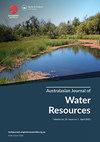不幸的分流:澳大利亚墨累-达令盆地回归环境水量调整的政策话语分析
IF 2.2
Q2 WATER RESOURCES
引用次数: 2
摘要
摘要墨累-达令流域计划是一项旨在将灌溉用水归还给环境的重大举措,被誉为世界级的水资源改革。《流域计划》的授权立法《水法》从《拉姆萨尔湿地公约》等国际条约中获得了宪法合法性。该法案规定,水必须从消费用途返回到环境中。设定的配额为2750 GL/年,但已被“可持续导流限额调整机制”(SDLAM)减少,旨在以更少的水实现同等的环境效益。我们提出了导致水改革被“淡化”的决策环境变化的综合。我们分析了水改革的政策话语,以评估SDLAM项目是否会取得符合澳大利亚国际条约义务的成果。我们发现SDLAM项目的目的与条约和水法的原则之间很少或根本没有一致之处。随着气候变化下水资源短缺的增加,试图用更少的水来保护湿地(包括河流),同时维持或增加灌溉改道可能会被证明是不适应的。需要对环境水政策和管理进行重大调整,以便有意义和有效地适应气候变化。本文章由计算机程序翻译,如有差异,请以英文原文为准。
Unfortunate diversions: a policy discourse analysis on the adjustment of the volume of water returned to the environment in the Murray-Darling Basin, Australia
ABSTRACT The Murray–Darling Basin Plan, a major initiative to return water from irrigators to the environment, has been lauded as world-class water reform. The enabling legislation for the Basin Plan, the Water Act, gains its constitutional legitimacy from international treaties such as the Ramsar Convention on Wetlands. This Act mandated that water be returned from consumptive uses to the environment. An allocation of 2,750 GL/yr was set but has been reduced by the ‘Sustainable Diversion Limit Adjustment Mechanism’ (SDLAM), intended to achieve equivalent environmental benefits with less water. We present a synthesis of changes in decision contexts that have led to water reforms being ‘watered down’. We analysed the policy discourse of water reform to assess whether SDLAM projects will achieve outcomes congruent with Australia’s international treaty obligations. We found little or no alignment between the purpose of the SDLAM projects and the principles of the treaties and the Water Act. As water scarcity increases under climate change, attempting to conserve wetlands (including rivers) with less water while maintaining or increasing irrigation diversions is likely to prove maladaptive. A major reframing of environmental water policy and management is required to enable meaningful and effective adaptation to climate change.
求助全文
通过发布文献求助,成功后即可免费获取论文全文。
去求助
来源期刊

Australasian Journal of Water Resources
WATER RESOURCES-
CiteScore
5.10
自引率
21.90%
发文量
25
期刊介绍:
The Australasian Journal of Water Resources ( AJWR) is a multi-disciplinary regional journal dedicated to scholarship, professional practice and discussion on water resources planning, management and policy. Its primary geographic focus is on Australia, New Zealand and the Pacific Islands. Papers from outside this region will also be welcomed if they contribute to an understanding of water resources issues in the region. Such contributions could be due to innovations applicable to the Australasian water community, or where clear linkages between studies in other parts of the world are linked to important issues or water planning, management, development and policy challenges in Australasia. These could include papers on global issues where Australasian impacts are clearly identified.
 求助内容:
求助内容: 应助结果提醒方式:
应助结果提醒方式:


